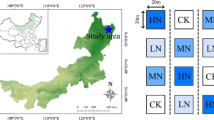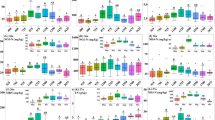Abstract
Nitrogen cycling process and dynamic change over 2 years were studied in 21-year-old planted dahurian larch (Lurix gmelinii (Rupr) Rupr.) in the eastern part of northern China. N concentrations in the plants varied by tissue, age, position in tree and season. In the aboveground components the N concentration was highest in foliage, followed by live branches, bolebark and bolewood. The organic N concentrations in undergrowth and herbs were higher than that in larch tree. The total amount of N accumulated in the larch ecosystem was 13167 kg.ha-1, in which the percentages of N storage in soil, living plants, dead standing and litter were 94.7%, 2.8%, 0.1% and 2.4%, respectively. The uptake of N by vegetation was 56 kg.ha-1.y-1, in which the retention and return were 24 kg.ha-1.y-1 and 32 kg. ha-1 y-1, respectively. Precipitation provided 13 kg.ha-1.y-1 of N, while N loss via runoff was 4 kg.ha-1.y-1 and therefore, the net gain of N by ecosystem was 9 kg.ha-1.y-1.
The simulation of N dynamic change showed that an increase in the age of stand was accompanied by a concomitant increase in N storage in the forest floor, whereas N flux from forest floor organic matter into soil would decrease, and consequently, growth rate of larch stands would reduce owing to the inadequacy of available N in the soil. The prediction indicated that the degradation of soil fertility in larch plantation might occur under continuous cropping. The study implied that release rate of N from litter into soil was the key factor in determining and regulating N cycling in larch plantation.
The understory minor vegetation in the larch stand plays an important role in speeding up N cycling. The timely thinning is needed to improve growth and development of shrubs and herbs, and to avert the potential soil degradation. The mixed stand of larch with either a certain proportion of broad-leaved or a moderately well developed understory vegetation should be encouraged.
Similar content being viewed by others
References
Allen S E 1989 Chemical Analysis of Ecological Materials. (2nd edition). Blackwell Scientific Publication, Oxford, London, Edinburgh. pp 118–133.
Bockheim J G, Lee S W and Leide J E 1983 Distribution and cycling of elements in a Pinus resinosa plantation ecosystem, Wisconsin. Can. J. For. Res. 13, 609–619.
Charley J L and Richards B N 1983 Nutrient allocation in plant communities: Mineral cycling in terrestrial ecosystems. In Encyclopaedia of Plant Physiology IV. Eds. O LLange, P SNoble, C BOsmond at al. Springer-Verlag, Berlin, Heidelberg, New York. New Series 12 D, 6–39.
Chapin F SIII 1983 Nitrogen and phosphorus nutrition and nutrient cycling by evergreen and deciduous understory shrubs in an Alaskan black spruce forest. Can. J. For. Res. 13, 773–781.
Chen N Q and Yin J D 1990 Studies on effects of secondary regeneration of larch pure plantation under the successive rotations. Proc. 2th Forest Silviculture Conf. Chin. Soc. For. pp 170–178. Forestry Press, China.
Cole D W 1981 Nutrient cycling in world forests. 17th IUFRO World Conference Proc. pp 139–160.
Cole D W and Johnson D W 1978 Mineral cycling in tropical forests. In Forest Soils and Land Use. Ed. C T Youngler. pp 342–356. Colorado State Univ.
Cole D W and Rapp M 1980 Elemental cycling in forest ecosystems. In Dynamic properties of forest ecosystems. Ed. D E Reichle. pp 341–409. Cambridge Univ. Press.
Ding B Y, Liu S Y and Chai T J 1990 A study on biological productivity of man-made larch communities Acta Phytoecol. Sinica 14, 226–235.
Duvigneaud P and Denaeyer-DeSmet S 1970 Biological cycling of minerals in temperate deciduous forests. In Analysis of Temperate Forest Ecosystems. Ed. D EReichle. pp 199–225. Springer-Verlag, New York.
Feng L and Yang Y 1985 A study on biomass and production of three types of dahurian larch virgin forests. Scientia Silvae Sinica 21, 86–92.
Feng Z W, Chen C Y and Zhang J W 1985 Studies on the accumulation, distribution and cycling of nutrient elements in the ecosystem of the pure stand of subtropical Cunninghamia lanceolata forests. Acta Phytoecol. Geobot. Sinica 9, 245–256.
Flanagan P W and Cleve KVan 1983 Nutrient cycling in relation to decomposition and organic matter quality in taiga ecosystem. Can. J. For. Res. 13, 795–817.
Kimmins J P and Hawkes B C 1978 Distribution and chemistry of fine roots in a white spruce-subalpine fir stand in British Columbia: implication for management. Can. J. For. Res. 8, 265–279.
Lamb D 1975 Patterns of nitrogen mineralization in the forest floor of stands of Pinus radiata on different soil. J. Ecol. 63, 615–625.
Lamb D 1976 Decomposition of organic matter on the forest floor of Pinus radiata plantations. J. Soil Sci. 27, 206–217.
Lieth H and Whittaker R H 1975 Primary Productivity of the Biospherea. Springer-Verlag, New York, Inc. 237–263.
Lin P and Lin G 1985 Studies on the mangrove ecosystem of the jiulong jiang river estuary in China. IV. The accumulation and biological cycle of nitrogen and phosphorus elements in the Kandelia canael community. Acta Phytoecol. Geologica Sinica 9, 21–31.
Liu S R, Chai T J and Cai Y X 1991 Patterns and processes of net primary productivity in a dahurian larch plantation ecosystem. Northeast Forestry University Press, China 1, 419–427.
Liu S R and Li J 1993 A study on distribution and cycling of micronutrient elements in larch plantation ecosystem. Scientia Silvae Sinica 29, 2–11.
Maclean D A and Wein R W 1977 Changes in understory vegetation with increasing stand age in new Brunswick forests: Species composition, cover, biomass, and nutrients. Can. J. Bot. 55, 2818–2831.
Nadelhoffer K J, Aber J D and Melillo J M 1983 Leaf-litter production and soil organic matter dynamics along a nitrogen-availability gradient in Southern Wisconsin (USA). Can. J. For. Res. 13, 12–21.
Nie D P, Dong S R and Shen G F 1986 Studies on nutrient cycling in Chinese pine plantation. III. Biological cycling and nutrient Balances. J. Beijing For. Univ. 2, 8–19.
Pritchett W L 1979 Properties and management of forest soil. John Wiley Sons, Inc., New York, Chichester, Brisbane, Toronto. pp 189–208.
Troelstra S R, Lotz L A P, Wagenaar R and Sluimer L 1990 Temporal and spatial variability in soil nutrient status of a former beach plain. Plant and Soil 127, 1–12.
VanCleve K, Oliver L, Schlentner R, Viereck L A and Dyrness C T 1983 Productivity and nutrient cycling in taiga forest ecosystems. Can. J. For. Res. 13, 747–766.
Zeng S Q and Liu L Z 1986 Biogeochemical characteristics of the mountain rain forests in Hainnan Island. China. Ecol. Sci. 2, 36–44.
Author information
Authors and Affiliations
Rights and permissions
About this article
Cite this article
Liu, S. Nitrogen cycling and dynamic analysis of man made larch forest ecosystem. Plant Soil 168, 391–397 (1995). https://doi.org/10.1007/BF00029352
Issue Date:
DOI: https://doi.org/10.1007/BF00029352




